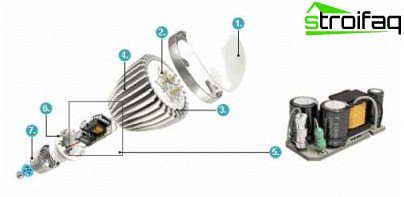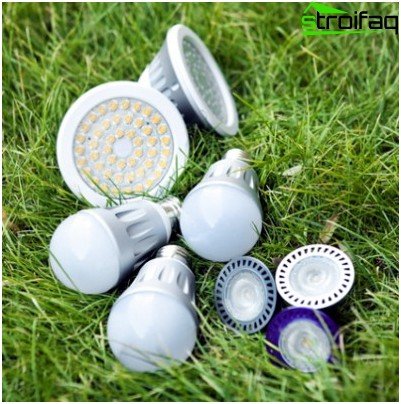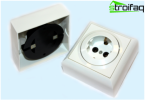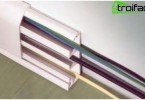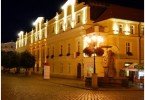All about energy-saving lamps
Energy-saving lamps are presented on the market by linear and compact fluorescent lamps (low pressure gas discharge), which contain mercury, and LED, which are environmentally friendly devices. A common characteristic that unites them is that these illuminators are able to significantly save energy, while they have significantly greater light output compared to conventional incandescent lamps. The latter will cease to exist in the coming years, as world governments everywhere set the course for the use of energy-saving technologies. People have to choose between devices of the next generation. But what kind of energy-saving lamps is better, how do they differ and what should you pay attention to when buying? We will answer further and many other questions..
Content
- About linear and compact devices
- Types of compact fluorescent lamps
- The advantages of fluorescent lamps
- Criteria for choosing a fluorescent lamp
About linear and compact devices
Compact Fluorescent Lamp (CFL) It has a curved bulb shape that allows you to place it in small smaller fixtures. Usually they are used in domestic conditions and replace incandescent lamps in conventional luminaires. Also used in specific types of lighting fixtures. Such a lamp contains inert gases (such as argon, neon) and mercury vapor, from the inside its body covers a layer of a phosphor. When exposed to high voltage, electrons begin to move in it. The collision of electrons with mercury atoms results in invisible ultraviolet radiation, which is transformed into visible light (thanks to the phosphor layer).
CFL consists of three parts:
- the base with which it connects to the network;
- Electronic ballast, i.e. electronic ballast. It is he who turns on the ignition and further supports the burning of the lamp. He also translates the voltage of 220 V into that which is necessary for CFL to work in the “flicker-free” mode.
- flasks.
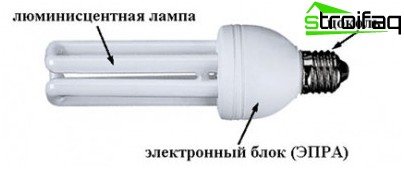
Components of a fluorescent lamp
These components may vary, which leads to varieties of the device.
Linear fluorescent lamp can be circular, straight or U-shaped. The 2-pole rectilinear fluorescent lamp looks like a glass tube. Special glass legs are welded at its ends, on which electrodes are mounted. A thin layer of powder – phosphor is applied to the inner surface of such a tube. It is filled with an inert gas, dosed quantity of mercury and hermetically sealed..
Such lamps vary in diameter and length of the tube, as well as the width of the cap. The larger the handset, the greater the power consumption. It is usually used in offices and in factories..
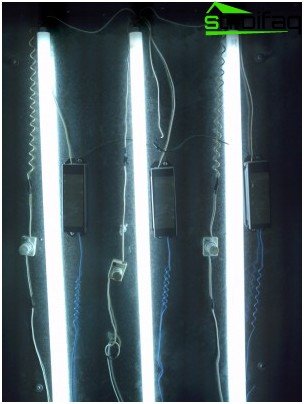
Energy-saving linear fluorescent lamps
The most widely used compact fluorescent lamps. Linear analogs are their “progenitors” and are gradually fading into the past. We will talk more about modern devices in more detail.
Types of compact fluorescent lamps
The domestic CFL market is formed mainly due to imports. Distributed products of such brands as General Electric, Philips, UNIEL, OSRAM, Navigator, Ecola, Compak. They are classified depending on the features of their components:
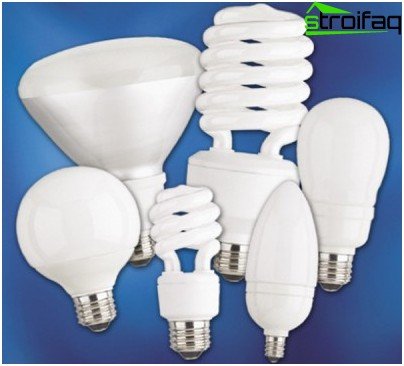
Varieties of compact energy-saving fluorescent lamps
1. On the base, which may be:
- 2D – for decorative lighting and for hermetic lighting of showers, G23 – for showers, bathrooms and wall lamps, 2G7, G24Q1, G24Q2, G24Q3 – used in industrial and domestic appliances,, G53 – used as energy-saving lamps for spotlights;
- E27 – under a conventional cartridge (most common);
- E14 – used under a small cartridge;
- E40 – under a large cartridge.
Lamps with socles E27, E14 – are installed in the lampholders of ordinary incandescent lamps, since they are most simple when installed in ordinary lamps. The numbers 27, 14 and 40 correspond to the diameter of the thread in standard units. Their declared service life can be from 3 thousand to 15 thousand hours. Lamps for such cartridges are available both with a diffuser and with an open tube.
2. By the color of the radiation, which happens:
- warm white;
- cold white color;
- neutral white;
- daylight.
3. Also according to the diameter of the flasks, which can be 7, 9, 12 and 17 mm.
4. In the form of CFL there are:
- U-shaped (3-arc, 4-arc, 6-arc);
- in the form of a spiral (there are from 3 – 85 watts).
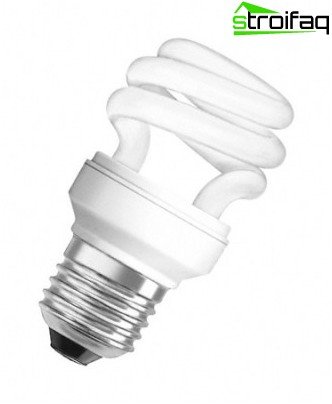
Energy-saving lamp in the form of a spiral
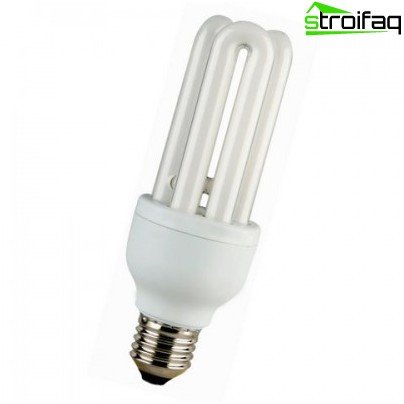
U-shaped energy-saving lamp
Lamps in the form of a spiral are slightly smaller in size in contrast to the U-shaped ones due to the length, but they are equivalent in power to them. Appearance does not affect the functionality of the lighting device. But spiral lamps are more expensive in cost due to the more labor-intensive technology of their production.
The advantages of fluorescent lamps
- They allow to reduce electric energy consumption by 80% without detriment to the luminous flux, which remains the same as that of incandescent lamps.
- Long term of work (up to 15 thousand hours). Which is 6-14 times more compared to a conventional light bulb. This makes it possible to install them in places where frequent notice of lighting equipment may be difficult (for example, in a room with high ceilings).
- They produce less heat than conventional incandescent lamps. This allows the use of small CFLs of high power in especially complex designs of lamps, sconces, chandeliers. In such lighting fixtures, an incandescent lamp is able to melt a wire or a plastic part of a cartridge.
- CFL light is much more sparing for the eyes and spreads much more evenly. This is achieved due to the special design of the device. After all, the casing area of fluorescent lamps is larger than that of a filament spiral.
- CFLs can have a variety of color temperatures. This means that its colors can be different, for example, 2700 K – warm white light, 4200 K – daylight, 6400 K – cold-white color. Color temperature is measured on the Kelvin scale. Moreover, the colder the light temperature, the closer it is to red, and the warmer it is to blue. Thus, using CFL, you can diversify the lighting, make it much more original..
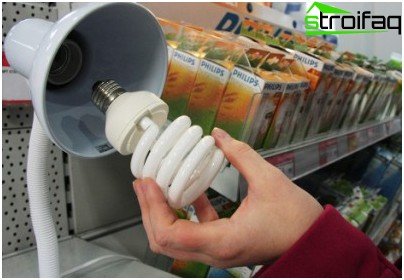
When choosing an energy-saving lamp, pay attention to the size of the base
Criteria for choosing a fluorescent lamp
- The size. You need to immediately figure out whether the lamp is suitable in size, whether it will fit into the lampholder or lamp socket. In other words – you need to choose the right base.
- Lamp power. The intensity of the glow will depend on this. For residential premises, it is not recommended to purchase CFLs with a power exceeding 15 – 25 watts, since the light will be very bright from a more powerful device.
- Life time. It is advisable to choose the lamp with the longest life.
- Colour temperature. You need to have an idea of color shades and choose the optimal one for your room. In a large hall, which usually gathers a lot of people, it is better to install a CFL of neutral white color, in the rest room, probably warm white.
- Price. U-bulb bulbs will be cheaper.
- The disadvantages of CFL. Whatever the advantages of energy-saving lamps, harm from them is also possible. After all, they contain mercury, which belongs to the 1st hazard class (the most toxic). In fluorescent energy-saving bulbs, mercury is in vapor form. If broken, mercury will easily begin to spread through the air. When it enters the lungs of a person, it accumulates there, spreading to other areas, and does not appear for a very long time, harming health. Fluorescent lamps contain 1 to 70 mg of mercury.
If an energy-saving lamp crashes, it is urgent to collect the residues in a container and close it tightly, treat the surface on which the mercury was a solution of potassium permanganate. At the same time, the room should be carefully ventilated..
LED lamp specifications
The second type of lamp, which is classified as energy-saving, are LED lamps. They are produced as finished devices (fixtures) and elements of fixtures (directly LED lamps). They are used in everyday life, in production, can have a different look, they are produced practically for all types of socles.
Consist of:
- Diffuser
- Actually LEDs
- The board on which they are attached
- The radiator that cools the LEDs
- Drivers
- Air vents designed for air circulation
- Cap
LED lamp components
The beam of light of LED lamps is rather narrow, approximately 60 degrees. Because of this, lamps with diffusers expanding the luminous flux are used to illuminate the rooms. But, for example, in table lamps where a narrow beam of light is needed, lamps without a diffuser are used.
Types of LED Devices
They differ constructively and depending on the scope of their application..
Depending on where the LED lamps are used, they distinguish:
- LED lamps designed for general lighting of apartments and offices
- LEDs for interior lighting
- LED lamps for landscape design and outdoor architectural lighting
- Explosion Proof LED Lights
- LED Street Light
- Industrial LED Spotlights
By the type of design features of the body, as well as depending on the properties of the emitted light, they distinguish:
- LED lamps for general use. These are the sources of the highest quality, diffused light, pleasing to the eyes, as close as possible to daylight. Used in residential premises and offices
- LED lamps with directional light. Are applied to illumination of shop windows, in interior lighting
- Linear LED lamps. They look like an oblong tube with a swivel base. Thanks to the design, the angle of the lamp glow can be easily changed in them. They are mainly used in office premises.
Varieties of energy-saving LED lamps
There are LED lamps and the type of cap:
- Flask (T). This is a tube lamp. They are produced with a special swivel base, made in several sizes: from 15.9 mm (T5) to 38.0 mm (T12).
- Edison Base (E). These are lamps with a threaded system that connects to a power source. It is considered the most common type of basement design. In the marking after E, a certain number is indicated, which characterizes the diameter of the threaded connection. Standard sizes are E27 and E14. They are designed to operate on a 220 V network, do not require adapters.
- Pin base (G). Such lamps are connected to the cartridge using a pin. Mounting plugs look like a pair of contacts of a certain length and thickness (can be either standard (for a 220 V network) or low-voltage.
- Other varieties of caps that are rare:
- S – spotlight;
- R – with recessed contact;
- In the pin;
- P – focusing.
The main advantages of LED lamps
- They are characterized by a very long service life, reaching 100 thousand hours.
- Consume little power (about 8 times less when compared to conventional incandescent bulbs)
- They are absolutely environmentally friendly, do not contain harmful substances, it is fearless to break them, therefore they are safe to operate. Easy to dispose of.
Landmarks for buying an LED lamp
- The brightness of the glow. It is worth focusing on a power of 12-20 watts.
- The color of the glow. The manufacturer usually indicates the color temperature of the lamp on the packaging. And the higher it is, the whiter the light.
- Angle of illumination. For general lighting buy lamps with a diffuser. For spotlights, it is not needed.
- Color rendering coefficient, which should be at least 90%.
We examined the main types and all the main characteristics of energy-saving lamps. We hope that this information will help you make the right choice, purchase a lamp with the optimal parameters that are best suited for lighting a particular room.


